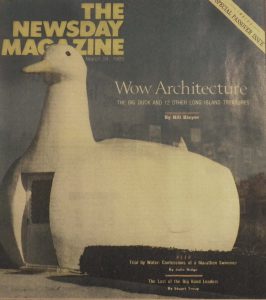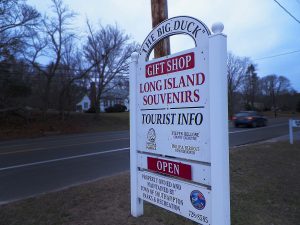For a two-week special edition to my historical architecture theme, I decided to deviate from my initial plans of staying within the boundaries of the five boroughs of New York City. Instead, I have made a crucial decision to focus on a landmark housed practically on the tip of Long Island (near the Hamptons) by name of The Big Duck. This monumental building was very important to modern architecture (which years range from the 1800’s to the early 2000’s) since it possibly could have been the beginning of a major style in the 1980’s, called Post-Modernism. Personally when I think of the beginning of Post-Modernism, I think of the infamous married architectural duo, Robert Venturi and Denise Scott-Brown. This couple was like the Mom and Dad of this movement since they practically created it and were the key figures in making it popular.
There’s an architectural philosophy that many modern architects, as well as in many other professions of the design world, strongly applied to their work, “Less is more…” by Ludwig Mies van der Rohe. This is a term commonly used in describing modern architecture since it was more common for structures to be honest and functional, leaving elaborate exterior adornments in the past. Venturi later coined his own term, “Less is a bore…” meaning that we should bring back some of the characteristics that we have already parted with; in a dire attempt to reestablish personality in structures since he thought that every building looked identical and they all took the form of boxes.
After Venturi and Scott-Brown traveled in various parts of America they noticed something, a trend. They found that roadside attraction businesses were something to be studied and analyzed. They found them to be the most honest pieces of architecture since they were not hiding what they were selling or what they truly were. They created their chain of analytics by using a structure called the Big Duck. The Big Duck is a 1930’s house that was built to sell duck influenced items to the driving public. People would drive by this oversized duck and want to pull over since they know what they are selling and what they were expected to purchase. From this Long Island distributor is where most people in 1932-1984 bought the infamous Pekin Duck and specialty items like duck eggs. They appreciated the different form of honesty and started basing their other structures on this billboard building. Others started to formulate their work on this philosophy and it soon became a trend. Which gives us buildings like The Longaberger Company building which literally looks like an oversized basket.
Even if certain parts of these buildings didn’t have any structural or operational reasoning, it was still considered important since it had stylistic necessity.
Tune in next week to see more of the historical side of the Big Duck now that I have explained why I find it so interesting that something so architecturally important is housed in New York.







